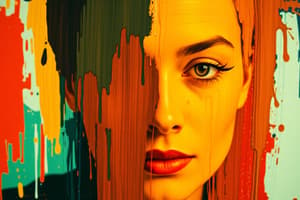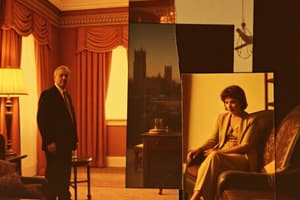Podcast
Questions and Answers
Cosa include l'arte della cinematografia nel cinema?
Cosa include l'arte della cinematografia nel cinema?
- L'uso esclusivo di attori di grande talento.
- L'interazione tra luce, composizione, inquadratura e movimento della telecamera. (correct)
- La modifica dei dialoghi per renderli più accattivanti.
- La creazione di effetti sonori per migliorare l'esperienza visiva.
Quali sono gli elementi principali che contribuiscono a creare il linguaggio visivo di un film?
Quali sono gli elementi principali che contribuiscono a creare il linguaggio visivo di un film?
- Costumi, scenografie e trucco.
- Luce, composizione, inquadratura e movimento della telecamera. (correct)
- Sceneggiatura, regia e montaggio.
- Effetti speciali e computer grafica.
Cosa fanno i direttori della fotografia per plasmare l'aspetto visivo di una scena?
Cosa fanno i direttori della fotografia per plasmare l'aspetto visivo di una scena?
- Regolano la velocità di ripresa per ottenere effetti speciali.
- Manipolano le fonti di luce per creare il mood desiderato. (correct)
- Modificano il colore dei costumi degli attori.
- Sovrappongono più tracce audio per aggiungere profondità al suono.
Cosa si intende per composizione nella cinematografia?
Cosa si intende per composizione nella cinematografia?
Quali tecniche compositiva utilizzano i direttori della fotografia per rendere le immagini visivamente accattivanti?
Quali tecniche compositiva utilizzano i direttori della fotografia per rendere le immagini visivamente accattivanti?
Come influenzano le decisioni sulla luce la luminosità dell'immagine cinematografica?
Come influenzano le decisioni sulla luce la luminosità dell'immagine cinematografica?
Come possono i direttori della fotografia manipolare la prospettiva dello spettatore in una scena?
Come possono i direttori della fotografia manipolare la prospettiva dello spettatore in una scena?
Cosa fa il processo di color grading?
Cosa fa il processo di color grading?
Quali sono alcune tecniche di movimento della cinepresa menzionate nel testo?
Quali sono alcune tecniche di movimento della cinepresa menzionate nel testo?
Qual è uno dei ruoli principali dei direttori della fotografia in un film?
Qual è uno dei ruoli principali dei direttori della fotografia in un film?
Come i filtri possono influenzare l'aspetto visivo di un film?
Come i filtri possono influenzare l'aspetto visivo di un film?
Cosa significa 'depth of field' nella cinematografia?
Cosa significa 'depth of field' nella cinematografia?
Flashcards are hidden until you start studying
Study Notes
Cinematography in Film
Cinematography, the art and craft of capturing moving images on screen, is a fundamental aspect of filmmaking that contributes significantly to the visual storytelling experience. It's the interplay of light, composition, framing, and camera movement that creates the visual language and mood of a movie. Let's delve into the world of cinematography and uncover the techniques and elements that shape the visual style of films.
Light and Exposure
Cinematographers manipulate light to shape the look and feel of a scene. They control light sources, such as lamps, practicals (lighting devices integrated into the set design), and natural light, to craft the desired mood and atmosphere. They also employ techniques like filtration, bouncing light, and gelling to shape the light's quality and color. These choices influence the exposure, or brightness of the image, and create different looks and effects.
Composition and Framing
Composition refers to how elements are arranged within the frame of the camera, while framing is the technique of deciding which part of the scene to include within the frame. These principles help cinematographers guide the viewer's attention to specific elements in the scene and contribute to the overall narrative.
Cinematographers use various compositional techniques, including the rule of thirds, leading lines, and balance, to create visually appealing and meaningful images. They also leverage framing devices like depth of field, camera angle, and lens focal length to control the viewer's perspective and emphasize specific elements in the frame.
Camera Movement
Camera movement adds dynamic energy and visual interest to a film. Cinematographers employ various techniques, including tracking shots, panning, tilting, and crane or dolly movements, to create a sense of movement and immersion in the scene. These techniques also help cinematographers to manipulate the viewer's perspective, draw attention to certain elements, and create tension or excitement in the scene.
Lens and Filters
Cinematographers choose lenses and filters to further shape the visual style and mood of a film. Lenses affect the field of view, depth of field, and image distortion, while filters modify the light's color, contrast, and other characteristics. These choices help cinematographers to create the desired visual style and emphasize specific elements in the scene.
Color and Grading
Color grading is the process of adjusting the colors of an image to achieve a desired look and mood. Cinematographers work closely with colorists to create a consistent and cohesive color palette throughout the film. They consider the color of the actors' skin tones, wardrobe, and set design to create a harmonious and immersive visual experience.
Shot Design and Sequence
Cinematographers design individual shots and sequences to create narrative flow and visual interest. They consider the tempo, rhythm, and pacing of the film to create a dynamic and engaging viewing experience. They also collaborate with directors and editors to plan and execute shots that contribute to the overall storytelling and visual style of the film.
Conclusion
Cinematography is a multifaceted craft that involves manipulating light, composition, framing, camera movement, lens and filter choices, color, and shot design to create a visually captivating and emotionally engaging film. Cinematographers play a critical role in shaping the visual language and mood of a film, and their choices help to convey the narrative and immerse the viewer in the story. Understanding these elements and principles helps us appreciate the artistry and craftsmanship of cinematography and better appreciate the films we watch.
Studying That Suits You
Use AI to generate personalized quizzes and flashcards to suit your learning preferences.




